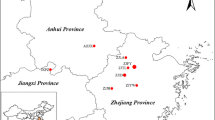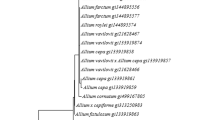Abstract
Eight species of the genus Asparagus, members of the group of European species closely related to A. officinalis, were analysed using internal transcribed spacer (ITS), and expressed sequence tag-derived simple sequence repeat (EST-SSR) markers, as well as cytological observations of their hybrids, to study their phylogenetic relationships and the possibility of broadening the narrow genetic base of cultivated varieties. Phylogenetic analysis using ITS data revealed two major clades: clade I consisting of A. acutifolius and clade II (referred to in this study as the ‘officinalis group’) comprised of sequences derived from species closely related to A. officinalis; but the different species within the ‘officinalis group’ could not be clearly separated. In contrast, cluster analysis of EST-SSR marker data showed six major clades and clearly separated each population, grouping most of the genotypes from each population together. That is, EST-SSR markers were found to be more informative than ITS markers about the relationships within the ‘officinalis group’, indicating that EST-SSR markers are more useful than ITS sequences for establishing phylogenetic relationships at the intrageneric level. All the crosses carried out at the same ploidy level were successful. The high crossability, together with the regular meiotic behaviour and high pollen and seed fertility observed in the interspecific hybrids analysed, suggest relatively close relationships between the species studied. We conclude that the group of species classified in the ‘officinalis group’ are in the primary gene pool, indicating that these species could be used to increase the genetic diversity of the cultivated species. In addition, the tetraploid landrace “Morado de Huétor” could be employed as a bridge to generate new cultivated germplasm.


Similar content being viewed by others
References
Alberti P, Casali PE, Barbaglio E, Toppino L, Mennella G, Falavigna A (2004) Interspecific hybridization for Asparagus breeding. In: Proceedings of the XLVIII Italian society SIFV-SIGA joint meeting, pp 78–79
Álvarez I, Wendel JF (2003) Ribosomal ITS sequences and plant phylogenetic inference. Mol Phylogenet Evol 29:417–434
Baldwin BG, Sanderson MJ, Porter JM, Wojciechowski MF, Campbell CS, Donoghue MJ (1995) The ITS region of nuclear ribosomal DNA: a valuable source of evidence on angiosperm phylogeny. Ann Missouri Bot Gard 82:247–277
Bozzini A (1959) Revisione cito-systematica del genre Asparagus L. I. Le spezie di Asparagus della flora Italiana e chiave analitica per la loro determinazione. Caryologia 12:199–264
Bozzini A (1963) Interspecific hybridization and experimental mutagenesis in breeding Asparagus. Genet Agrar 16:212–218
Brettin TS, Sink KC (1992) Allozyme variation and genetics in asparagus. J Hered 83:383–385
Bruvo R, Michiels NK, D’Souza TG, Schulenburg H (2004) A simple method for the calculation of microsatellite genotype distances irrespective of ploidy level. Mol Ecol 13:2101–2106
Caruso M, Federici CT, Roose ML (2008) EST-SSR markers for asparagus genetic diversity evaluation and cultivar identification. Mol Breed 21:195–204
Clark LV, Jasieniuk M (2011) POLYSAT: an R package for polyploid microsatellite analysis. Mol Ecol Res 11:562–566
Clifford HT, Conran JG (1987) 2. Asparagus, 3. Protasparagus, 4. Myrsiphyllum. In: George AS (ed) Flora of Australia. Australian Government Publishing Service, Canberra, pp 159–164
De Melo NF, Guerra M (2001) Karyotypic stability in asparagus (Asparagus officinalis L.) cultivars revealed by rDNA in situ hybridization. Cytologia 66:127–131
Drummond AJ, Ashton B, Cheung M, Heled J, Kearse M, Moir R, Stones-Havas S, Thierer T, Wilson A (2010) Geneious v5.0, Available from http://www.geneious.com
Ellison JH (1986) Asparagus breeding. In: Breeding vegetable crops. AVI Publishing Co., pp 521–569
Eujayl I, Sledge MK, Wang L, May GD, Chekhovskiy K, Zwonitzer JC, Mian MAR (2004) Medicago truncatula EST-SSRs reveal cross-species genetic markers for Medicago spp. Theor Appl Genet 108:414–422
Falavigna A, Alberti P, Casali PE, Toppino L, Huaisong W, Mennella G (2008) Interspecific hybridization for asparagus breeding in Italy. Acta Hort (ISHS) 776:291–298
Felsenstein J (1985) Confidence limits on phylogenies: an approach using the bootstrap. Evolution 39:783–791
Felsenstein J (1993) PHYLIP (Phylogeny Inference Package) version 35c Distributed by the author Department of Genetics. University of Washington, Seattle
Fukuda T, Ashizawa H, Suzuki R, Ochiai T, Nakamura T, Kanno A, Kameya T, Yokoyama J (2005) Molecular phylogeny of the genus Asparagus (Asparagaceae) inferred from plastid petB intron and petD-rpoA intergenic spacer sequences. Plant Spec Biol 20:121–132
Geoffriau E, Denoue D, Rameau C (1992) Assessment of genetic variation among asparagus (Asparagus officinalis L.) populations and cultivars: agromorphological and isozymic data. Euphytica 61:169–179
Harlan JR, de Wet JMJ (1971) Toward a rational classification of cultivated plants. Taxonomy 20:509–517
Kay QON, Davies EW, Rich TCG (2001) Taxonomy of the western European endemic Asparagus prostratus (A. officinalis subsp. prostratus) (Asparagaceae). Bot J Linn Soc 137:127–137
Khandka DK, Nejidat A, Golan-Goldhirsh A (1996) Polymorphism and DNA markers for asparagus cultivars identified by random amplified polymorphic DNA. Euphytica 87:39–44
Knaflewsky M (1996) Genealogy of asparagus cultivars. In: Proceedings VIII International Asparagus Symposium, pp 87–91
Komarov V, Shishkin B, Bobrov E (1935) Flora of the USSR. Akademiya Nauk SSSR, Moscow and Leningrad, pp 325–339
Kubota S, Konno I, Kanno A (2012) Molecular phylogeny of the genus Asparagus (Asparagaceae) explains interspecific crossability between the garden asparagus (A. officinalis) and other Asparagus species. Theor Appl Genet 124:345–354
Levin DA (2002) Polyploidy: incidence, types, and modes of establishment. The role of chromosomal change in plant evolution. Oxford University Press, Oxford, pp 84–133
Marcellan ON, Camadro EL (1996) Self- and cross-incompatibility in Asparagus officinalis and Asparagus densiflorus cv. Sprengeri. Can J Bot 74:1621–1625
Marcellan ON, Camadro EL (1999) Formation and development of embryo and endosperm in intra- and inter-specific crosses of Asparagus officinalis and A. densiflorus cv. Sprengeri. Sci Hortic 81:1–11
McCollum GD (1988) Asp 8271 and Asp 8284 Asparagus Germplasm. HortScience 23:641
Moreno R, Espejo JA, Cabrera A, Millán T, Gil J (2006) Ploidic and molecular analysis of ‘Morado de Huetor’ asparagus (Asparagus officinalis L.) population; a Spanish tetraploid landrace. Genet Res Crop Evol 53:729–736
Moreno R, Espejo JA, Cabrera A, Gil J (2008) Origin of tetraploid cultivated asparagus landraces inferred from nuclear ribosomal DNA internal transcribed spacers’ polymorphisms. Ann Appl Biol 153:233–241
Peterson A, John H, Koch E, Peterson J (2004) A molecular phylogeny of the genus Gagea (Liliaceae) in Germany inferred from non-coding chloroplast and nuclear DNA sequences. Plant Syst Evol 245:145–162
Pieroni A (2005) Gathering food from the wild. Cultural history of plants. Routledge, New York, pp 29–44
Reamon-Büttner SM, Schmidt T, Jung C (1999) AFLPs represent highly repetitive sequences in Asparagus officinalis L. Chromosom Res 7:297–304
Riccardi P, Casali PE, Mercati F, Falavigna A, Sunseri F (2011) Genetic characterization of asparagus doubled haploids collection and wild relatives. Sci Hortic 130:691–700
Rich LK, Rich TCG (1998) Distribution and ecology of Asparagus prostratus. I. Cantabria, Northern Spain. Unpublished report, National Museum & Galleries
Rich LK, Rich TCG (1999) Distribution and ecology of Asparagus prostratus. V. Asturias, Northern Spain. Unpublished report, National Museum & Galleries
Rich TCG, Bennallick IJ, Cordrey L, Kay QON, Lockton A, Rich LK (2002) Distribution and population sizes of Asparagus prostratus Dumort. Wild asparagus in Britain. Watsonia, pp 183-192
Roa AC, Chavarriaga-Aguirre P, Duque MC, Maya MM, Bonierbale MW, Iglesias C, Tohme J (2000) Cross-species amplification of cassava (Manihot esculenta) (Euphorbiaceae) microsatellites: allelic polymorphism and degree of relationship. Am J Bot 87:1647–1655
Sánchez-Gómez P, Vera-Pérez JB, Jiménez-Martínez JF (2008) Liliaceae. Asparagus maritimus (L.) Mill. In: Bañares Á, BLanca G, Güemes J, Moreno JC, Ortiz S (eds) Atlas y Libro Rojo de la Flora Vascular Amenazada de España. Adenda. (Ministerio de Medio Ambiente, y Medio Rural y Marino)-Sociedad Española de Biología de la Conservación de Plantas. Madrid, pp 24–25
Sarabi B, Hassandokht MR, Hassani ME, Masoumi TR, Rich T (2010) Evaluation of genetic diversity among some Iranian wild asparagus populations using morphological characteristics and RAPD markers. Sci Hortic 126:1–7
Scott KD, Eggler P, Seaton G, Rossetto M, Ablett EM, Lee LS, Henry RJ (2000) Analysis of SSRs derived from grape ESTs. Theor Appl Genet 100:723–726
Simpson MG (2006) Plant molecular systematics. Plant systematics. Elsevier Academic Press, Amsterdam, pp 477–491
Štajner N, Bohanec B, Javornik B (2002) Genetic variability of economically important Asparagus species as revealed by genome size analysis and rDNA ITS polymorphisms. Plant Sci 162:931–937
Stebbins GL (1971) Chromosomal Evolution in Higher Plants. Addison-Wesley, London
Stephens CT, De Vries RM, Sink KC (1989) Evaluation of asparagus species for resistance to Fusarium oxysporum f. sp. asparagi and F. moniliforme. HortScience 24:365–368
Sturtevant EL (1890) History of garden vegetables. Am Nat 24:719–744
Thiel T, Michalek W, Varshney RK, Graner A (2003) Exploiting EST databases for the development and characterization of gene-derived SSR-markers in barley (Hordeum vulgare L.). Theor Appl Genet 106:411–422
Torres AM, Weeden NF, Martín A (1993) Linkage among isozyme, RFLP and RAPD markers in Vicia faba. Theor Appl Genet 85:937–945
Valdes B (1975) Notas sobre algunas especies europeaus de Asparagus (Liliaceae). Anales Instituto Botánico A J Cavanilles 32:1079–1092
Valdes B (1980) Asparagus L. In: Tutin TG, Heywood VH, Burges NA, Valentine D (eds) Flora Europaea. Cambridge University Press, Cambridge, pp 71–73
Venezia A, Soressi GP, Falavigna A (1993) Assessment of hybrids and varieties of Asparagus for resistance to Stemphylium vesicarium. Agric Ric 141:49–54
Acknowledgments
The first author acknowledges grant support from the Spanish program Torres Quevedo, financed in part by EU funds (ESF). This work was funded by the Spanish projects AGL2008-05229 and AGL2011-2395, financed in part by EU funds (ERDF). The authors are also grateful for support received from the University of Córdoba, member of the Agrifood Campus of International Excellence (ceiA3).
Author information
Authors and Affiliations
Corresponding author
Rights and permissions
About this article
Cite this article
Castro, P., Gil, J., Cabrera, A. et al. Assessment of genetic diversity and phylogenetic relationships in Asparagus species related to Asparagus officinalis . Genet Resour Crop Evol 60, 1275–1288 (2013). https://doi.org/10.1007/s10722-012-9918-3
Received:
Accepted:
Published:
Issue Date:
DOI: https://doi.org/10.1007/s10722-012-9918-3




